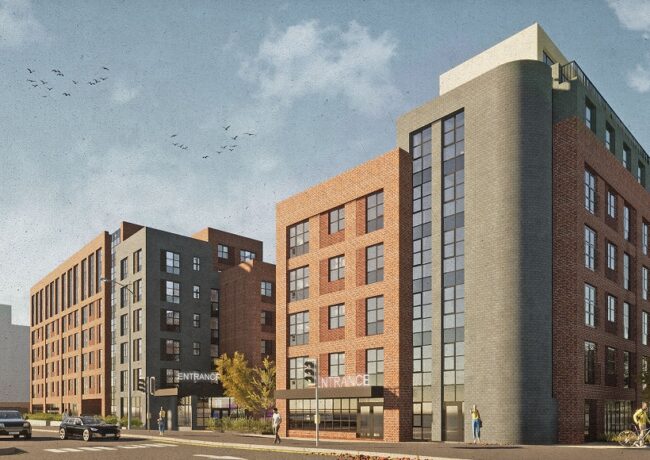Event Summary
Future of Shopping Centres: Summary + pictures
Turmoil and opportunities caused by e-commerce, the rise of food and beverage occupiers, the changing shape of anchor store deals were all discussed at Place North West’s Future of Shopping Centres breakfast event.
See gallery below
Around 100 delegates from across the retail property sector attended the event, sponsored by Lambert Smith Hampton and Hill Dickinson. There was a palpable sense of optimism and energy in the room suggesting that after years in the doldrums the market was back on the up.
Looking at the role of shopping centres in the market today, expert speakers included  Criona Collins, director of Lambert Smith Hampton; John Sullivan, director of dcinex and co-founder of Light Cinemas; Martyn McDonald, partner of Hill Dickinson; and Marcus Hadfield, managing partner of McCann Connected.
Criona Collins, director of Lambert Smith Hampton; John Sullivan, director of dcinex and co-founder of Light Cinemas; Martyn McDonald, partner of Hill Dickinson; and Marcus Hadfield, managing partner of McCann Connected.
As a specialist on cinema anchors within new developments, ex-Warner Village property director Sullivan is overseeing the installation of a Light Cinema branch within Bolton’s revamped Market Place Shopping Centre being developed by Moorgarth.
“I don’t know what’s happening with cinema,” he quipped. “Cinema hasn’t changed much over the past 20 years. For many of us if we revisit the same cinema we went to for the first time as a child the experience is pretty much the same. However, the market is starting to change now and it’s changing fast, probably faster than the big three operators care to admit.”
Speaking of the Market Place scheme, Sullivan said: “It’s going to be sensational as a centre. The cinema will be a lovely tiara on a beautiful cake, alongside the redevelopment of the Vaults and the presence of Living Ventures’s design team will only strengthen the food and beverage offering.”
Following a series of strategic acquisitions in the last year, Lambert Smith Hampton has boosted its retail offer across the country. Companies absorbed into LSH include BTWShiells in Belfast, where Collins is based, and most recently Tushingham Moore in Manchester.
Speaking on the acquisition drive, Collins said: “LSH is investing in specific geographical areas, and for the first time in a long time LSH can provide high-value retail expertise. It’s a perfect time for the market as shopping centre investment in the UK accounts for a third of all purchases across the EU, at around £22bn.
“We’re not back to pre-recession levels just yet, but 2015 is looking good. While 2016 is expected to be patchy and subdued like 2014, in 2017 there will be a surge and 2018 will continue to be strong.”
As an advisor to rapidly-expanding chains such as Poundland, Hill Dickinson’s McDonald emphasised that clients were still highly motivated by short-term targets, despite increased stability in the market.
“Clients are positive, but conscious of quarterly targets; the quarter immediately ahead is always the most important and this drives their opening strategies. New developments which take longer to come through are being put to one side for something that can be slotted into next quarter’s figures.
“There is a distinct shopping list when a retailer goes into a transaction, such as landlord contributions and rent-free periods. There is a strength in numbers, and retailers are increasingly talking to others in the centre to co-ordinate openings. One condition of a Poundland lease is that it is not obliged to take occupation for a fit-out until an anchor tenant has opened or is advanced.”
Collins agreed: “Heads of terms have gone from one page to practically a whole lease length. This is not necessarily a bad thing; if the recession has taught as anything is that the more thought through and detailed a deal is the better.
She continued: “Retailers have to stand together, and need the right adjacencies. This means the anchor tenant is still the cornerstone of a shopping centre, but this has changed from the prominence of a supermarket anchor since the big four retreated and consolidated. We’re seeing smaller mini-anchors such as Poundland and B&M. Lidl and Aldi are picking up where the big four left off, but there’s still a need for the likes of Marks & Spencer and House of Fraser to occupy.”
As managing partner of McCann Connected, Hadfield has advised clients such as Costa Coffee, Argos and Homebase on digital campaigns.
“The rule with digital is, just because it’s there doesn’t mean it’s good,” he stressed. “90% of all tech out there is rot. Clients are obsessed with digital and driving traffic, both in tech terms and actual footfall.
“Digital is about easing the customer experience, but also can be invaluable as a data capture tool to tell you about footfall and spend, if used in an intelligent way.
“This could be something as easy as helping with car parking, a way-finder app, or a voucher-based application. But you need to think what the customer is getting out of it. There’s no point in a wayfinder app if most visitors are in the shopping centre every week and already know their way around.”
The prominence of e-commerce had not resulted in the death of bricks-and-mortar shops as many had feared, according to McDonald: “Of course digital trends and how they are advancing are of major interest to retailers. But there needs to be a mix, and many are introducing tech as a requirement but still ensuring that shops serve their function as a physical place.”
The internet had filled a niche in terms of convenience, said Hadfield, but was not likely to replace the experience of visiting an actual shop.
“Going to a shopping centre is now a leisure pursuit, whereas the internet is for need. Increasing emphasis on digital will mean that the over-reliance on square footage will change. Because of this, we’re seeing an increase in the opening of showcase stores with tech to display the full range in a smaller space than previously required.”
The cinema industry had been predictably sluggish in adopting the latest technologies, Light co-founder Sullivan said: “The use of digital so far in cinemas has been minimal, but we’re now starting to see how that could evolve. The potential is massive; in cinemas across the world we’re already seeing innovations such as live screening a surgery taking place in Washington to doctors in Korea, car launches in Bucharest, and that’s only scratching the surface.”
Size does matter when it comes to securing a cinema tenant, Sullivan stressed: “In terms of cinema sizes, the bigger the cinema, the more money they can pay the landlord. More than 60,000 sq ft is where the money is, when you get to a certain level of cinema it’s all cream and can deliver rents of around £22/sq ft. When a cinema is around 15,000 sq ft to 25,000 sq ft it struggles to earn.”
The success of a cinema as a leisure anchor is dependent on its neighbouring occupiers, said Sullivan: “Cinema-going is a twinned event, twinned with retail and food and drink offer, but also even things like going to the dentist or meeting friends. This fact would have me quaking in my boots if I was a leisure park. Smaller towns have got a chance now in terms of leisure, as cinemas can have a huge impact on the evening market. Town centres can recreate what they were, as a gathering place for the community.”
Click image to launch gallery
- Packed room at City Tower
- Panel members Criona Collins, Marcus Hadfield, Martyn McDonald, John Sullivan
- John Sullivan
- McDonald answers a question
- Stunning view from Red Room 1
- Future of Shopping Centres Breakfast
- Plenty of opportunity for networking
- Council representatives in the audience included ex-Magnus owner Nick Hynes for Cheshire East Council
- Hadfield explains the digital imperative in retail
- Criona Collins joined LSH through the takeover of BTW Shiells in Belfast last year























